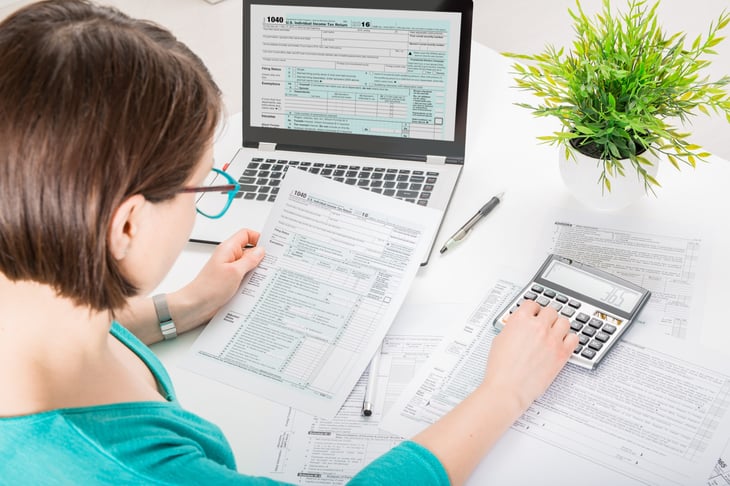
Editor’s Note: This story originally appeared on The Penny Hoarder.
If you’re one of the millions of people who worked remotely in 2022, you may be wondering whether that means a sweet deduction at tax time.
Hold up, though: The IRS has strict rules about taking the home office deduction — and they changed drastically under the Tax Cuts and Jobs Act, which passed in late 2017.
7 Essential Rules for Claiming a Work-From-Home Tax Deduction

Thinking about claiming a home office deduction on your tax return?
Follow these tips to avoid raising any eyebrows at the IRS when you file your 2022 tax return, which is due on April 18, 2023.
1. You can’t claim it if you’re a regular employee, even if your company requires you to work from home

If you’re employed by a company and you work from home, you can’t deduct home office space from your taxes. This applies whether you’re a permanent remote worker or if your office still hasn’t returned to in-person operations because of the COVID-19 pandemic.
The rule of thumb is that if you’re a W-2 employee, you’re not eligible for a work-from-home tax deduction.
This wasn’t always the case, though.
The Tax Cuts and Jobs Act suspended the deduction for miscellaneous unreimbursed employee business expenses, which allowed you to claim a home office if you worked from home for the convenience of your employer, provided that you itemized your tax deductions.
The 2017 law nearly doubled the standard deduction. As a result, many people who once saved money by itemizing now have a lower tax bill when they take the standard deduction.
2. If you have a regular job but you also have self-employment income, you can qualify

If you’re self-employed — whether you own a business or you’re a freelancer, gig worker or independent contractor — you probably can take the deduction, even if you’re also a full-time employee of a company you don’t own.
It doesn’t matter if you work from home at that full-time job or work from an office, as long as you meet the other criteria that we’ll discuss shortly.
You’re allowed to deduct only the gross income you earn from self-employment, though. That means if you earned $1,000 from your side hustle plus a $50,000 salary from your regular job that you do remotely, $1,000 is the most you can deduct.
3. It needs to be a separate space that you use exclusively for business

The IRS requires that you have a space that you use “exclusively and regularly” for business purposes. If you have an extra bedroom and you use it solely as your office space, you’re allowed to deduct the space — and that space alone.
So if your house is 1,000 square feet and the home office is 200 square feet, you’re allowed to deduct 20% of your home expenses.
But if that home office also doubles as a guest bedroom, it wouldn’t qualify. Same goes for if you’re using that space to do your day job.
The IRS takes the word “exclusively” pretty seriously here when it says you need to use the space exclusively for your business purposes.
To avoid running afoul of the rules, be cautious about what you keep in your home office. Photos, posters and other decorations are fine. But if you move your gaming console, exercise equipment or a TV into your office, that’s probably not.
Even mixing personal books with professional books could technically cross the line.
4. You don’t need a separate room

There needs to be a clear division between your home office space and your personal space. That doesn’t mean you have to have an entire room that you use as an office to take the deduction, though.
Suppose you have a desk area in that extra bedroom. You can still claim a portion of the room as long as there’s a marker between your office space and the rest of the room.
5. The space needs to be your principal place of business

To deduct your home office, it needs to be your principal place of business. But that doesn’t mean you have to conduct all your business activities in the space.
If you’re a handyman and you get paid to fix things at other people’s houses, but you handle the bulk of your paperwork, billing and phone calls in your home office, that’s allowed.
There are some exceptions if you operate a day care center or you store inventory. If either of these scenarios apply, check out the IRS rules.
6. Mortgage and rent aren’t the only expenses you can deduct

If you use 20% of your home as an office, you can deduct 20% of your mortgage or rent. But that’s not all you can deduct.
You’re also allowed to deduct expenses like real estate taxes, homeowners insurance and utilities, though in this example, you’d be allowed to deduct only 20% of any of these expenses.
Be careful here, though. You can deduct expenses only for the part of the home you use for business purposes. So using the example above, if you pay someone to mow your lawn or you’re painting your kitchen, you don’t get to deduct 20% of the expenses.
You’ll also need to account for depreciation if you own the home. That can get complicated.
Consider consulting with a tax professional in this situation. If you sell your home for a profit, you’ll owe capital gains taxes on the depreciation. Whenever you’re claiming deductions, it’s essential to keep good records so you can provide them to the IRS if necessary.
If you don’t want to deal with extensive record-keeping or deducting depreciation, the IRS offers a simplified option: You can take a deduction of $5 per square foot, up to a maximum of 300 square feet.
This method will probably result in a smaller deduction, but it’s less complicated than the regular method.
7. Relax: You probably won’t get audited if you follow the rules

The home office deduction has a notorious reputation as an audit trigger, but it’s mostly undeserved. Deducting your home office expenses is perfectly legal, provided that you follow the IRS guidelines.
A more likely audit trigger: You deduct a huge amount of expenses relative to the income you report, regardless of whether they’re related to a home office.
It’s essential to be ready in case you are audited, though. Make sure you can provide a copy of your mortgage or lease, insurance policies, tax records, utility bills, etc., so you can prove your deductions were warranted.
You’ll also want to take pictures and be prepared to provide a diagram of your setup to the IRS if necessary.
As always, consult with a tax adviser or consider using tax prep software like TurboTax or H&R Block if you’re not sure whether the expense you’re deducting is allowable.
It’s best to shell out a little extra money now to avoid the headache of an audit later.
